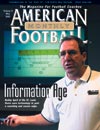Running From The Shotgun Formation
Middle Tennessee State University’s offense exploits holes to gain serious ground yardage against spread out defenses expecting a pass.
by: Darin HinshawRunning Backs Coach, Middle Tennessee State University©
More from this issue
When
coaches think of running the football, they generally get in two
tight ends and two backs, and MASH. The personnel on the field allows
you take care of blocking most defenses and when you finish drawing
your play everyone, at least in theory, can be blocked. You also
believe you have a bigger, as strong, or stronger blocker then the
defense. Many great coaches use that theory today.
Here at Middle Tennessee State University, we use two tight ends
and two backs and run the football also. We also do it another way
– against all instincts with running the football. We spread
the defense horizontally to create vertical seams in the running
game.
Understand the theory never changes in running the football, only
the formations. You don’t use four wide receivers and one back
and run it every so often as a change up. Your players will never
respect it. You as the coach must create a mindset that we will
run the football first – and be successful – before we
even look to throw it.
When your players understand that running the football is the priority,
they respect the call. Your players understand that a successful
running game opens up passing lanes and then you throw the ball
to take advantage of the defense.
Here is a base 8-man front defense vs. tight formation and a four
wide, one back formation. I will use this to explain the Inside
Zone (
See Diagram 1) and Outside Zone (
See Diagram 2):
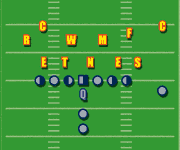 Diagram 1.
Diagram 1. |
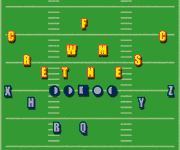 Diagram 2.
Diagram 2. |
A huge key in spreading defenses and running the football is to
run the football from the shotgun. When you see shotgun, you generally
think pass. In running the football from the shotgun, it is important
to use the quarterback in all your running schemes. Use the quarterback
as a blocker. Well not actually as a blocker (we don’t want
to get that “special guy” hurt), but accountable for a
defender. You can not do that from under center.
INSIDE ZONE
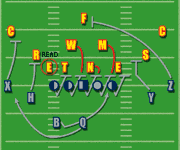 Diagram 3.
Diagram 3. |
I will explain the inside zone from the shotgun. First you block
the play against four wide receivers and one back that is two-by-two.
I will explain the play from the following diagram:
See Diagram 3.
The number one key you look for when calling the Inside Zone is
that the ends are lined up outside and in an outside leverage position.
RT: You are stepping to reach the outside number of the defensive
end. If the end slants inside, you will press him to the RG and
look for the scraping Mike LB’er. It is extremely important
you do not let the end penetrate. It may take a double-team to secure
him and then come off on the Mike LB’er.
RG: You are stepping to reach the end if he slants, then stay on
track to where the Mike LB’er will be. If he over runs you,
stay on him and push him outside. If he slow-plays, then cover him
up.
C: Reach the outside number of the shaded nose tackle. If the nose
tackle slants inside you will press him to the left guard, staying
on track to pick up the scraping Will LB’er. If the nose tackle
slants outside, wash him down the line. The back will cut behind
the nose.
LG: You are stepping to reach the nose tackle if he slants, then
stay on track to where the Will LB’er will be. If he over runs
you, stay on him and push him outside. If he slow-plays, then cover
him up.
LT: You are stepping to reach the outside number of the defensive
tackle. If the tackle slants outside, you will pin the tackle outside.
If the tackle slants inside, you will try and gain leverage and
wash him down the line. If the back is cutting back, he will cut
all the way behind your block.
X: You will stalk block the corner. If the quarterback pulls the
ball and runs, X must stalk the corner.
H: You will stalk the Rover LB’er. If the quarterback pulls
the ball and runs, H must stalk the Rover LB’er.
Y: Inside release and gain leverage on the Sam LB’er. Stay
on the block at all costs. You do not have to pin him or turn him,
just stay on him and let the back cut around your block. You can
cut him, but understand the timing can not allow the defender to
get up and make a tackle.
Z: Sprint to the free safety. Usually the free safety is a better
tackler than the corner – we will let the corner go and secure
the free safety. You can cut the free safety.
QB: First, secure the snap. Reach ball to the back and bucket your
foot slightly to the back. This puts your eyes directly on the defensive
end. Ride the back and read the defensive end. If the end comes
upfield, then release the ball to the back and boot outside the
end. If the end slants down and follows the LT (chasing the back),
pull the ball and sprint for width and read your receivers running
the ball.
 Diagram 4.
Diagram 4. |
B: Turn step and your shoulders will be parallel with the LOS.
Sprint in front of the quarterback and then turn downfield at a
landmark of the inside hip of the RT. You will stay on that path
and read the RT’s block. If the RT gains leverage outside on
the defensive end and no color of the defensive end’s jersey
is outside, then run outside and read Y’s block. If the defensive
end gains leverage outside of the RT, then chase the inside hip
of the RT and cut upfield. If a defender is going to cross your
face at any time, cut the ball back and pound it inside reading
second level defenders. You may cut all the way back behind the
LT.
Here is an example of the inside zone with two tight ends and two
backs. You can easily leave two defenders unblocked:
See Diagram 4.
OUTSIDE ZONE
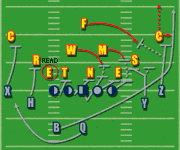 Diagram 5.
Diagram 5. |
Now you see the defensive ends are tight to almost head up. Now
it is time to call the Outside Zone. Your mentality changes on offense
when you call the Outside Zone. You are now trying to get the ball
outside. Also, if the cover down defenders are cheating inside of
the slot receivers, you don’t have to start throwing the ball.
You can run the Outside Zone and pin those defenders. I will explain
the play from the following diagram:
See Diagram 5.
RT: Reach the outside shoulder of the defensive end and pass him
to the RG. Watch for the defensive end slanting outside. Block on
and outside 45-degree track to gain leverage on the Mike LB’er
and pin him inside. RT and RG cover the end and Mike LB’er.
RG: Step hard to reach the defensive end and pin the end inside.
If the end slants inside, pin him. If the defensive end slants outside,
still try and reach him and stay on a 45-degree track to pin the
Mike LB’er or cover him up. RT and RG have the end and Mike
LB’er.
C: Overreach the nose tackle and pass him to the LG. If the nose
tackle slants inside the LG should overtake him, and then get on
a 45-degree track to pin the Will LB’er or cover him up. If
the nose tackle slants outside, continue to reach him and pin him.
The C and LG have the Nose and Will LB’er.
LG: Step hard to reach the nose tackle. The center should help and
allow you to pin the nose. If the nose tackle slants inside, overtake
him and pin him. If the nose tackle slants outside, get on a 45-degree
track and look to pin the Will LB’er. If you cannot pin the
Will LB’er, cover him up and ride him across the field. Note:
If the center gets leverage outside the nose tackle, you should
be able to clip the nose tackle to allow the center to get to the
Will LB’er. The C and LG have the nose tackle and Will LB’er.
LT: Overreach the defensive tackle and pin him. If the tackle slants
outside, then pin him. If the tackle slants inside, then wash the
tackle, or clip him down.
X: You will stalk block the corner. If the quarterback pulls the
ball and runs, X must stalk the corner.
H: You will stalk the Rover LB’er. If the quarterback pulls
the ball and runs, H must stalk the Rover LB’er.
Y: If the Sam LB’er is head up, release outside and block the
outside number of the defender. You cannot lose leverage –
stay on the outside. If the Sam LB’er is aligned far inside,
crack him and explode through the defender. This block is important
to get the back outside of the defense. The Sam LB’er will
try and turn the play back inside. You can cut him only when you
know the back can gain outside leverage.
Z: Release to the outside of the corner to block the outside number
of the defender. If the corner holds his ground or comes upfield
block the corner. If the corner begins to gain depth, attack his
outside to block him – but if the free safety is attacking
and is a bigger threat, come off the corner and crack the free safety.
QB: First, secure the snap. Reach the football to the back and bucket
your foot slightly to the back. This puts your eyes directly on
the defensive end. Ride the back and read the defensive end. If
the end comes upfield, then release the ball to the back and boot
outside the end. If the end slants down and follows the LT (chasing
the back), pull the ball and sprint for width and read your receivers
running the ball.
B: Turn step and your shoulders will be parallel with the LOS. Sprint
in front of the quarterback and then turn downfield at a landmark
of five yards outside the RT. The back’s goal is to run the
ball outside and stay outside. Stay on track all the way to the
sideline – until you get three yards from the sideline –
and turn up. If a defender is being blocked across your face at
any time, cut up and then immediately get back on track outside.
The goal of the Outside Zone is to make the beginning of the play
look like the Inside Zone and when the defense attacks, stretch
the play outside and gain leverage outside on all blocks.
The Inside Zone and Outside Zone from the shotgun are great combinations.
Using the quarterback as a reader on the backside defensive end
is the key that allows the offensive line to block five men in the
box when there are actually six men in the box. This is an advantage
that can frustrate defenses and force them to push defenders closer
and closer to the box. This allows you to use the passing game to
take full advantage of seams and weaknesses in the defense.
Your receivers must understand the theory of the play. Backside
rules are important, because of the quarterback pulling the ball
and becoming a runner. Front side rules for the receivers are important
on the Inside Zone vs. Outside Zone. They must understand that to
throw the football, they must be able to block first and execute
the running game to open the pass game.
The running back must understand the difference between Inside Zone
vs. Outside Zone. The landmark is different and the mentality is
different, but the plays are very similar. The Inside Zone is to
attack downhill and cut back reading defensive lineman. The Outside
Zone is to stretch the defense and read outside blocks.
Understand, defenses will align coverdown (R & S) defenders
to try and force you to not call these plays. As the coach, you
must understand this and have answers to these problems. A good
Free Safety can also align down in the box. One answer is to call
these as play-action to take advantage of quick flat passes as well
as vertical passes.
MTSU finished seventh in the country in rushing and fifth in the
country in total offense. Remember, your mentality as an offense
staff will be reflected by your players. If you want a great running
game, your players will!
Nation's Best 2001 Seal
American Football Monthly recognizes the Nation’s Best
football programs each season based on detailed analysis of each school’s
overall record and statistical performances on offense, defense or
special teams. The Nation’s Best honor is given to a limited
number of programs at all levels who truly separate themselves from
the pack in one or more areas of the game.
